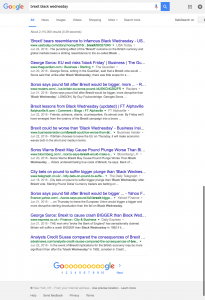In the lead up to, and aftermath of, the Brexit referendum vote in June, you may have seen more than one reference comparing the potential fall-out to “Black Wednesday”.
While that is not turning out to be entirely comparable, (Pound Sterling Live said on 7/25/16 that “Although Sterling is down almost 12% trade-weighted since the Brexit vote, it is up 3% from its early July lows and is unchanged month-to-date.”) it occurs to me that non-professional-economists may not remember, or may never have heard of Black Wednesday. Black Wednesday is known as the day (the 16th of September, 1992) that one man single handedly initiated a buying and selling frenzy that brought down the British Pound Sterling. To tell you how he did it, I’m going to give you just a bit of background.
As a precursor to the Euro being the singular currency for most of the European Union, the European Exchange Rate mechanism was created in 1979 as as way for countries to keep their national currencies. Since Germany had the strongest Post WWII economy, even decades after the war, the other countries agreed to fix their exchange rates with the Deutschmark. Rather than letting the capital market set exchange rates, they agreed to enter the ERM with a set exchange rate with the Deutschmark and then maintain an exchange rate between their national currencies within either plus or minus 6% of that agreed-upon rate. So when England entered the ERM with a value of 2.95 Deutschmarks per pound sterling, they were essentially promising to keep their currency at -or close to- that value indefinitely.
Now, you can’t just walk in saying your currency is worth more than it is, and you can’t undervalue it either. In order to maintain that 6% plus-or-minus in fluctuating markets and economies, the government has to participate to keep the rate steady. They can either buy up or sell off their own currency on the open market. Buying it would cause the currency to appreciate in value, and selling it can devalue the currency. In this way, a government can tweak the value of their money as it changes value naturally. The other option is to change interest rates to direct investing and spending, either raising or lowering interest rates can influence currency values in either direction, but interest rates also affect the whole economy, not just the value of your currency, so this is a less than desirable option.
In the early 1990’s, the British economy wasn’t faring too well. In 1992, there was a massive global recession, and England was feeling the impact. Unemployment went from 7.7% up to 12.7% in less than two years. Ordinarily a government could lower interest rates to increase spending and investing during an employment ordeal like this one, but that would devalue the pound to a rate below the acceptable variant amount from where they entered the ERM. This left the British government unable to ease the recession.
It was then that people started to realize that when Britain entered the ERM at a value of 2.95 Deutschmarks per pound sterling was too high a price for England to maintain. The only thing that kept the pound from plummeting was the British government’s promise that it would keep the value up by buying its own pounds.
One man, George Soros, a hedge fund founder and manager in New York, realized how weak the pound was, and that if enough pressure was put on the pound and the British government, the entire system could be forced into devaluing the British currency. All summer, Soros and his hedge fund had been building a $1.5 billion dollar position betting that the price of the pound would fall. In September, the following message went out over the newswaves: “The President of the Bundesbank, Professor Helmut Schlesinger, does not rule out the possibility that, even after the realignment and the cut in German interest rates, one or two currencies could come under pressure before the referendum in France. He conceded in an interview that the problems are of course not solved completely by the measures taken.”
Soros, as well as the rest of the financial market, knew that the German was referring to Britain’s currency, and that’s when it all hit the fan. From Priceonomics: “that morning, Soros and his fund increased their short position against the British pound from $1.5 to $10 billion. It was the perfect bet with a mitigated downside and a limitless upside. It was like betting on a coin flip, where if the coin lands on heads (the pound devalues), they make a lot of money. If the coin lands on tails (the exchange rates remained fixed), they only lose a small amount of money on loan interest. That’s the kind of bet Soros would pour money into all the day, even if he had to borrow billions.”
Essentially, the whole world saw what Soros was doing and joined in the fray. People were snatching up and selling pounds as fast as they could, and the government of the UK just couldn’t keep up. There are more events that happened that day, but in the end, Soros and his intense buying and selling incited the rest of the financial market to follow his lead. That one day of buying and selling British currency was enough to devalue the pound dramatically. Britain had to exit the ERM to float its currency on the market by the end of that single business day.

